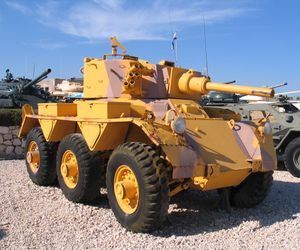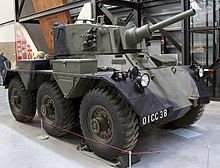Alvis Saladin: Difference between revisions
+wiki-links |
→Surviving Vehicles: Adding details of surviving Saladin's at Bovington |
||
| Line 61: | Line 61: | ||
Several Saladin Armoured Car parked at a tank garage at The Indonesian Army 4th Cavalry Battalion. |
Several Saladin Armoured Car parked at a tank garage at The Indonesian Army 4th Cavalry Battalion. |
||
There are three surviving Saladin Armoured Cars in [[Bovington Tank Museum]], Dorset, England. One, in all over green, is displayed in the "Tank Story" Exhibition. The second, in all over tan, is in operational condition and used in events. The third, in a tan and green camouflage pattern, is part of the Museum's reserve collection and is stored in the Vehicle Conservation Centre. |
|||
There is a Saladin Armoured Car in [[Bovington Tank Museum]], Dorset, England. |
|||
There is a Saladin Armoured Car in [[Norfolk Tank Museum]], Norfolk, England. Can be seen running at various time during the year. |
There is a Saladin Armoured Car in [[Norfolk Tank Museum]], Norfolk, England. Can be seen running at various time during the year. |
||
Revision as of 16:54, 3 July 2014
This article needs additional citations for verification. (January 2013) |
| Alvis Saladin | |
|---|---|
 FV 601 Saladin in Yad la-Shiryon museum, Latrun. | |
| Type | Armoured car |
| Place of origin | United Kingdom |
| Production history | |
| Manufacturer | Alvis |
| Specifications | |
| Mass | 11.6 t |
| Length | 4.93 m |
| Width | 2.54 m |
| Height | 2.39 m |
| Crew | 3 |
| Armour | up to 32 mm |
Main armament | 76 mm L5A1 gun |
Secondary armament | 2 x M1919A4 machine guns |
| Engine | Rolls-Royce B80 Mk.6A, 8 cyl petrol 170 hp (127 kW) |
| Power/weight | 15.5 hp/tonne |
| Suspension | 6x6 wheel |
Operational range | 400 km |
| Maximum speed | 72 km/h |
The Saladin (FV601) is a six-wheeled armoured car built by Alvis, and fitted with a 76mm gun.
Used extensively by the British Army, it replaced the AEC Armoured Car that had been in service since World War II.
History
The Saladin was the armoured car of Alvis' FV600 series, using similar suspension and drivetrain components to the Saracen armoured personnel carrier, Stalwart High Mobility Load Carrier and Salamander fire tender. It is named after the warrior Saladin, Alvis using names beginning with an "S" for the whole range of FV600 vehicles.
The Saladin was widely used by the Sultan of Oman armed forces throughout the Dhofar conflict and saw extensive action during the period 1972 to 1976, supporting ground forces and on Convoy patrol etc. Often crewed by British servicemen (Loan Soldiers) / Omani servicemen, the Sultan's Armoured Car Squadron consisted of an estimated 36 Saladins. They saw extensive action supporting troops from the British SAS, Oman Firqa, Oman regulars and Iranian forces in the conflict with the Adoo. The Squadron's vehicles were regularly attacked by Katyusha rockets, anti tank mines, Rocket Propelled Grenades and light and heavy machine gun fire. Many vehicles were mined and repaired and after the end of the conflict in 1976 the Saladin remained in Service until the early 1980s. An unpublished account called " The Tinned Equivalent" was written in 1977 and details many of the events of that period of conflict.
The Saladin was used by B sqn 16/5 Lancers during their defence of Nicosia airport in 1974 and subsequent armed recce operations under the banner of the UN. During the invasion of Kuwait, Saladins were filmed on the Streets of Kuwait City defending Kuwait against Iraqi forces during the 1990 Invasion.
Indonesian Army (TNI AD) use the Saladin for "KOSTRAD Cavalry Battalion", "KOSTRAD Recon Company" and Armoured Car Company.
The Australian Army mounted Saladin turrets on M113A1 APCs to produce the Fire Support Vehicle. This was later renamed as the Medium Reconnaissance Vehicle after the somewhat unreliable turret[citation needed] was replaced by the turret from the FV101 Scorpion Light Tank. Royal Australian Armoured Corps(RAAC) personnel referred to them as "Beasts". The Sri Lanka Armoured Corps used Saladins extensively during the early stages of the Sri Lankan Civil War and remained in reserve status till the end of the war in 2009. It forms the Tank Crew pin of the Sri Lanka Armoured Corps.
Saladin armoured cars could be seen in the streets of the Honduran Capital Tegucigalpa in the 2009 coup against President Manuel Zelaya.[citation needed]
Surviving Vehicles


There is an FV 601 Saladin in Yad la-Shiryon museum, Latrun.
There is an Alvis Saladin at Sri Lanka Armoured Corps Training Centre, Anuradhapura - a gate guard.
Several Saladin Armoured Car parked at a tank garage at The Indonesian Army 4th Cavalry Battalion.
There are three surviving Saladin Armoured Cars in Bovington Tank Museum, Dorset, England. One, in all over green, is displayed in the "Tank Story" Exhibition. The second, in all over tan, is in operational condition and used in events. The third, in a tan and green camouflage pattern, is part of the Museum's reserve collection and is stored in the Vehicle Conservation Centre.
There is a Saladin Armoured Car in Norfolk Tank Museum, Norfolk, England. Can be seen running at various time during the year.
There is a Saladin at the York depot of the Queen's Own Yeomanry, a Territorial Army regiment.
There is a Saladin at the Aldershot Army Museum [1]
There is also a non-functioning Alvis Saladin displayed outside the Lebanese Army's Military Outpost in the mountain region of Baabda located between Hammana and Chbaniyeh.
An American college sports enthusiasts club in Knoxville, Tennessee, the "Big Orange Army" operates a Saladin painted orange as an advertising device.
There is a privately owned Saladin in the Hurst-Euless-Bedford area of Texas.
There is a privately owned Saladin in the Vancouver, British Columbia area of Canada.
There is a Saladin at the Inniskillings Museum in Enniskillen Co Fermanagh N Ireland.
Numerous Saladin are surviving in Australia, one example is on display at the RAAC Memorial and Tank Museum Puckapunyal Vic.[2] and another complete operational, privately owned ex-British Saladin exists in the outer metropolitan region of Sydney. Many ex-Australian Army Saladin remain turretless because of the fitting of Saladin turrets on M113 carriers to make the Fire Support Vehicle (M113-A1 FSV) used in the Vietnam conflict.
Operators
 Australia[3]
Australia[3] Germany (German Federal Police)
Germany (German Federal Police) Ghana
Ghana Honduras
Honduras Indonesia
Indonesia Jordan
Jordan Kenya
Kenya Kuwait
Kuwait Lebanon
Lebanon Maldives
Maldives Mauritania
Mauritania Oman
Oman Portugal
Portugal Sri Lanka[4]
Sri Lanka[4] Sudan[5]
Sudan[5] Tunisia
Tunisia Uganda[6]
Uganda[6] United Kingdom
United Kingdom Yemen
Yemen Qatar[7]
Qatar[7] United Arab Emirates
United Arab Emirates
References
- ^ http://www3.hants.gov.uk/aldershot-museum/aldershot-collections.htm
- ^ http://www.armytankmuseum.com.au/i-vd.htm
- ^ [1]
- ^ Sri Lanka Army Web Site, Organization
- ^ Richard Lobban, Jr. Global Security Watch: Sudan (2010 ed.). Greenwood Publishing Group. p. 182. ISBN 978-0-313-35332-1.
- ^ http://links.org.au/node/2784
- ^ https://milinme.wordpress.com/category/saladin/
